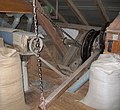Mill brake elevator
A mill brake elevator is used in the mills for vertical passenger transport and occurs mainly in water - occasionally also in windmills . Goods are mostly moved vertically with their own weight, elevator or pneumatics .
function
It is driven by a winding drum that is controlled by the person using the elevator via a control cable. For upward travel, this is pressed against a running friction disc. The winding drum is set in motion by friction and winds up the suspension rope, the elevator goes up. If the elevator user lets go of the control rope, the winding drum falls back into the brake caliper, the drum is braked and the elevator stops.
If the journey is to go downwards, the winding drum is only raised so far that it is lifted out of the brake caliper, the roller slips and the elevator goes down due to its own weight.
Statutory Regulations
Since January 1, 2010, mill brake elevators are no longer allowed to be operated in Germany. The temporary protection for the operation of existing plants in Section 27 (3) of the Industrial Safety Ordinance expired at this point after multiple extensions. In mills with a grinding capacity of more than ten tons per day , the operation of mill brake elevators was no longer permitted since January 1, 1995 due to the relevant previous regulation, the elevator ordinance . Mill brake elevators were no longer allowed to be installed on October 1st, 1988. Were in the way of the existing plants grandfathering the technical principles for the construction of elevators applied by 1927th These principles already indicated that mill brake elevators did not have the safety devices that were common at the time.
photos
In 2013, the mill brake elevator built in 1865 is still in operation in Sundwiger Mühle :
Individual evidence
- ↑ 1st extension to 2004 by the second regulation amending the elevator regulation of December 16, 1994, 2nd extension by Article 9 of the regulation adapting the regulation on hazardous substances to the EC directive 98/24 / EC and other EC directives of 23 December 1994. December 2004.
- ↑ a b Elevator Ordinance of February 27, 1980 in the version of the First Ordinance amending the Elevator Ordinance of August 17, 1988.




